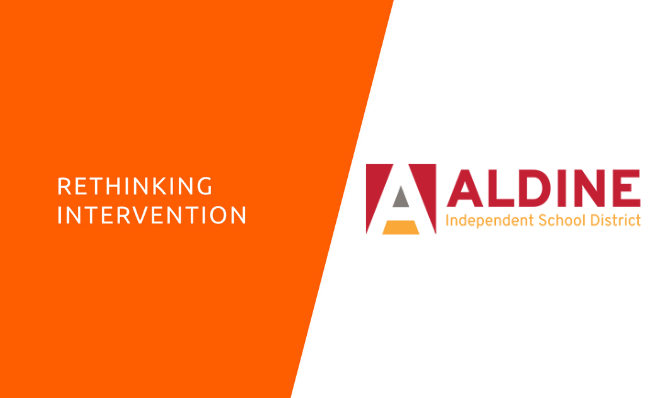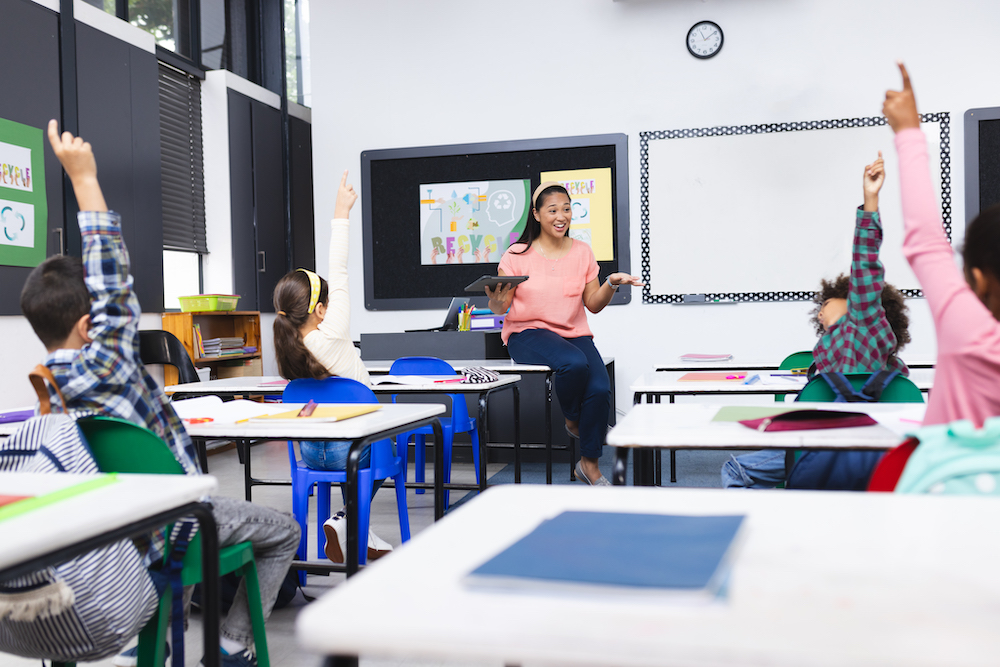
Aldine ISD Leadership Team
The Aldine ISD leadership team spoke to Emily Freitag to share their experiences during the COVID-19 pandemic. They discussed the challenges and successes of teaching, learning, and leading in the time of COVID-19—including how they are upholding high-expectations for all students, providing differentiated professional development (PD) for teachers, and strengthening relationships with families.
Featuring:
- Dr. LaTonya M. Goffney, Superintendent
- Dr. Todd M. Davis, Chief Academic Officer
- Sheleah D. Reed, APR, Chief Communications Officer
Watch the full conversation or read the abridged Q&A below.

EF: Dr. Goffney, you’re opening schools in a matter of days. Please bring us in on the context of your district and what is guiding your thinking right now.
LG: About a year ago, we launched our strategic plan with five priorities. The main focus is to improve student outcomes dramatically. Even amid COVID, that goal to dramatically improve student outcomes has not left our veins. To set the context, our students come from low-income households receiving free and reduced lunch meals. We’re 73% Hispanic, and we’re 23% African American. With the conditions in our community, not only are we helping to educate, but we are also trying to take care of the whole child and making sure that our students have food. We served over 1.6 million meals between late spring and now. As we take care of the whole child, we’re still moving forward in our strategic priority to improve student outcomes dramatically. We’ve launched a literacy curriculum, and we continue to provide job-embedded PD. All our teachers are experiencing their first year teaching in a “new normal”—think about that. We have teachers who are celebrating 30 years, but in reality, it’s their first year. I’m proud of what our Teaching and Learning Department has done under Dr. Davis’s leadership in providing just-in-time, job-embedded PD. We’re in the process of bringing some students back in. Still, we started school on August 17. There is already evidence of learning and evidence of teachers getting the support they need to teach in a virtual environment.
EF: Dr. Davis, what is guiding your leadership when you think about what kids need and what it’s going to take to support their learning?
TD: At the core of everything that we’re doing is making sure that we have equity, and making sure that the systems that we have in place ensure continuity of instruction in whatever setting our students choose, whether it be virtual or face-to-face. All actions come back to equity — it’s not just lip service. It’s integrated into every action we take when it comes to teaching and learning. There are many different layers of preparation that come into play to ensure that every student has equal access to a high-quality curriculum and high-quality instruction every day. Our team has focused on building professional learning for teachers, which is embedded, differentiated, available on their time. It supports the expectations that we set across the district for high-quality instruction and a high-quality curriculum. Now that we’re in the curriculum implementation phase and actually teaching and expecting learning from all students, we’re coming in and monitoring to ensure that the expectations are being fulfilled. We then look at how we, as leaders, can do better. We ask, “What can we do now to improve our teachers’ practice better? What can we do to support them to ensure that all students have equal outcomes at a high level?”
EF: What you have seen works in the task of supporting student learning and wellness that you really want to hold on to, particularly in a time when things are more disrupted and inequities are expanded?
TD: One thing that we know works is teachers connecting with students, genuinely building relationships with every single student, and students understanding that the teacher truly has their best interests at heart. When relationships are built and students are receiving meaningful work every day, students will be engaged. Students will complete the work, and the learning will be at a high level. The relationship piece is one non-negotiable.
LG: That is also the case for our teachers. We are expecting our teachers to provide relationships with the students. Still, one thing I’m proud of is how our Teaching and Learning Department has specifically created support for our teachers. As Dr. Davis said, it’s a tiered support system. They can choose from a menu of options to support what they need to meet our students’ needs. We could have easily just said, “We are expecting a virtual experience for our students — go figure it out.” Instead, we have digital learning specialists and content specialists holding our teachers’ hands, supporting them to meet the needs of our students.
EF: I’ve been deeply impressed by how much people have learned in the last six months. Where do you see learning accelerating across your teacher force? And what does that make you think about the future?
LG: One thing is that we’ve had some very innovative teachers, and they previously were hidden. As we transitioned to the fall from the spring, we had a summer learning experience. We typically have summer camps, but instead of summer camps, we had teachers come together to design learning in partnership with our Teaching and Learning Department.
Additionally, one of the most impressive things is how teachers have partnered with our parents in different ways. We typically have our “Muffins With Moms” and our “Doughnuts With Dads.” Still, our teachers have been able to partner with our parents differently because learning is happening at home. Now, we’re building out a Family and Community Engagement Office. FACE opened in late spring. The director hit the ground running ever since taking the lead. The office develops partnerships, shares resources, and provides training sessions for our families to equip them with how they can best help and support our students.
EF: Sheleah, I would love to hear where you’re seeing exciting progress and what you think that means for community connections.
SR: Dr. Goffney grounded the conversation in our strategic plan, and that’s where we should start.
Our strategic plan has five priorities. It begins with student achievement and goes through school culture, mission driven-leadership, operational efficiency, and community engagement and outreach. Even during COVID, we’ve been able to continue to support all of those initiatives and really tie everything that’s happening back to those things. Dr. Goffney alluded to the launch of the Family and Community Engagement Office. The executive director of FACE was announced on March 5 — our last day in our building was March 6. Who knew that her skill set and the department would be utilized so much in those months? That department has been tied directly to teaching and learning. They worked together to ensure that as Dr. Davis’s team launched an online learning platform, the Family and Community Engagement Office provided support. FACE has been providing training sessions for families and giving them opportunities to engage and share their feelings and experiences.
From my seat, one of the things that I’m focused on is telling the story of Aldine. I like to share the things that we are doing, how we have a new curriculum, how we are feeding students, and how all those things are tying together to make sure that our students still have choices and opportunities.
The phrase that I’ve adopted is ‘Never waste a crisis.’ We are in a pandemic, and there’s been a crisis almost every week. We’ve used it as an opportunity to pivot, grow, advance, and accelerate some of the things that would have been sitting on the shelf or would have been done in year two and launched through a whole cohort or a worker-group.
We’ve also uncovered the weaknesses that are happening. We know that access to technology is a challenge for our community, so we’ve been able to use these opportunities to connect with businesses and nonprofits to help support our students. Again, if we wouldn’t have had this crisis, that may have taken a little longer. Todd’s team was one of the first to launch an online platform. People copied our stuff—they use it as a best practice. We were first to say, “We’re giving everyone food, no matter what.” Our asynchronous plan is now being celebrated and highlighted, and used by the state to champion the work. So, I think that the things that we are doing for kids are not just going to benefit the kids in Aldine.
EF: And even beyond this moment, right?
SR: Right, it will be long term. The things that we’re doing will help the rest of the state. We all had to really lean in and do things that we may have asked permission to do before, and we may have been a little timid. But we’ve been able to do them, and we’ve been able to do them well. Of course, there have been stumbling blocks. Still, overall, it’s positioned us in a place and given us some confidence to really move forward and say that we’re doing what’s right for kids, and we’re underlining our strategic plan.
EF: Is there anything you’re hoping people don’t do or don’t perpetuate from past practices?
SR: We have to stop the attitude of, “Well, we’ve always done it this way.” And I also think that we have to lose the notion of, “When we come back, things will go back to whatever it was before.” There is no coming back to what it was before. We’ve got to throw that out the window. We have to take on technology. We have to support our students who are way smarter than us — who can develop unique ways of learning. We cannot get back into the habit of saying, “Let’s go back to the regular bell schedule.” We have to get past that. And from my perspective in communications, we cannot just say, “We’re going to send you a flyer in the mail.” We have to engage parents in all kinds of ways. We’re using social media, sending videos, we’re recording messages — we’re doing whatever it takes to meet people where they are.
TD: I hope that we have overcome the fear of technology. This has accelerated us into a space that previously felt like it was many years down the road. I’m very excited about our opportunity for blended learning as a norm in our teaching and learning processes moving forward.
LG: In a district of 67,000 students and with the demographics that we serve, without COVID, there is no way we would be as close to one-to-one as we are. By the time we receive all of our shipments, our district will be one-to-one. Pre-COVID, we would have had to arrange the design team, conduct a pilot, and do all these different things to make that happen. As we’re beginning to transition, one of the things that the Teaching and Learning team has been serious about is asking, “When the students come from home, and they come to school, do we take those computers out?” Blended learning, the one-to-one experiences, will become a part of the norm as we move forward and not pull out the worksheets or pull books out of the closet. The amazing training will not go back to how we’ve always done it.
Now I will be honest, I am a little bit tired of virtual meetings, but this way forward has been beneficial. Students, members of our Student Advisory Board, talked about how they do their work at night, and their grades have never been better. It’s taught them to be more responsible, and they feel like it’s good college preparation.
There is one thing I want to make clear. COVID can’t be the new excuse for low expectations. We can’t say, “We missed that because of COVID.” Or, “We would have been brought along if it hadn’t been for COVID.”
EF: This is an extraordinarily difficult time to lead. Thank you for everything you are doing and for bringing us in to learn from some of your leadership reflections in this remarkable time. It’s a privilege to be a partner to Aldine ISD.
—
You can find more conversations from the Rethinking Intervention series here.


